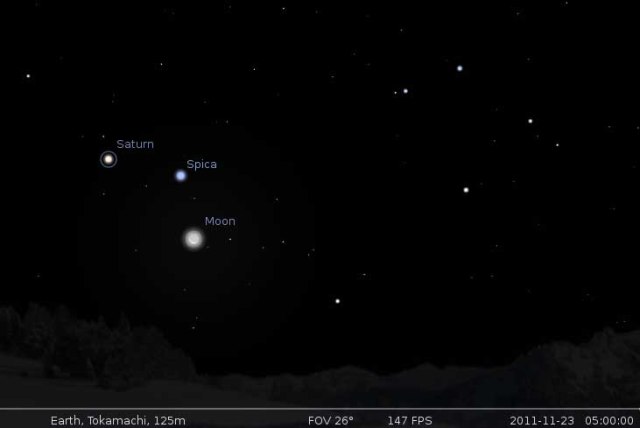
2011
Wednesday, December 21
This month I comet hunted only once at dusk on Dec. 13. At that time I expected
I could comet search over 1 hour, but I could only 20 minutes due to sudden
cloudiness. I am afraid that we cannot expect clear sky this month here in
Niigata.
I enjoyed SOHO image of C/2011 W3 that was discovered by Terry Lovejoy. He
discovered this comet using CCD but was discoverable visually in the southern
hemisphere. We were worried that the comet would have disappeared at the time
of the perihelion passage as it is a small size, but it survived! Unfortunately,
we cannot observe this comet from Japan. I expect an appearance of a great
comet: hopefully armaturefs visual discovery.
Wednesday, November 23
The percentage of cloud cover was high, but I saw some gaps in the sky and I
went on comet hunting. I set up my comet-seeker at 3:44a.m. and first of all I
enjoyed observing C/2010 G2 Hill. I trained my telescope at this comet using
Starmap Pro, iPod app, instead of the digital setting circles. The comet was
near Iota, Aurigae, and it was easy to spot. It was 11th magnitude.
While I was observing C/2010 G2, almost the entire sky was covered with cloud.
I had been waiting in my car around one hour, there appeared some gaps among
the cloud. I searched the constellation of Virgo, but I was clouded out again
in 10 minutes. I wondered if I took down my comet-seeker. At 5:05a.m. the time
when the twilight began, starry sky spread around Corvus and I comet hunted
till 5:30a.m. After all, I swept the sky only for 45 minutes through thin
cloud. Even so, I could identify 4 galaxies with magnitudes of 10-11th.
This was my third comet hunting session this month, but I could do it satisfactorily
only on November 2 due to the cloud.

When I was about to finish the session, thin moon with the earthlight, Spica and Saturn were shining together. These objects along with Corvusfs quadrangle formed well balanced geometric pattern. I felt happiness to take a look at this scenery, though the comet hunting session was interrupted by clouds and unsuccessful.
Tuesday, November 2
I comet hunted two consecutive predawns. I aimed my telescope at M65, M66, and
NGC3628, \all of them were seen in the same FOV, and began to search from
there. I identified many galaxies one after another. Sometimes several galaxies
came into the same FOV. If this was the case, I could not identify them all
using the digital setting circles due to lack of the resolution, and forced to
open Uranometoria 2000 Atlas to check them comparing positional relation among
stars and galaxies.
However, the situation has been different since last week. I purchased iPod (8GB)
and downloaded Deep Sky Browser (DSB). This app makes it possible to download
Digital Sky Survey (DSS) images, e.g. NGC, IC and UGC catalogs. You can set the
size of the image 5'x5', 10'x10', 30'x30', or 60'x60'. iPod requires WiFi
environment to download the images and you need to do at home.
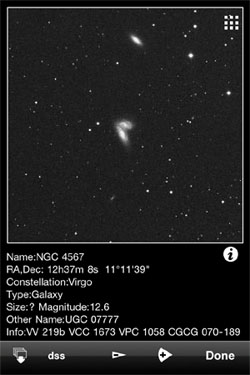
An image of galaxies displayed on iPod using Deep Sky Browser. From the top to the
center NGC4564, 4567, 4568. The image is 30' wide.
When I come across some galaxies in the same FOV, firstly, I identify one of
them using the digital setting circles (DSC). Secondary, I display that galaxy
using DSB with the image size of 30'x30', or 60'x60' so that all the deep sky
objects around that galaxy can be identified. It is interesting to use DSS
images as you can see the structure of the galaxy that you cannot clearly
recognize by visual observation. In fact I thought NGC4567 and 4568 (above) were
one galaxy at a first glance, but I found it consisted of the two to see DSS
image. Once I knew the feature I could recognize two galaxies by visual
observation. This predawn, I enjoyed comet hunting using this gadget, and identified
44 galaxies.
Another app, Starmap Pro contains full catalog of NGC and IC. As for stars, it
includes SAO, Tycho 2, HD and Hipparcos catalogs, and you can download orbital
elements of comets.
Both the apps are very handy and convenient that makes comet searching more
exciting. I use red-colored plastic plate for night vision.
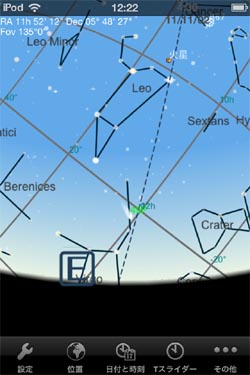

45P Honda-Mrkos-Pajdusakova is displayed
using Starmap Pro.
Left: wide area; right: 68x, 1.3 degrees FOV. The
magnification is shown as 67x since round-off is not applied.
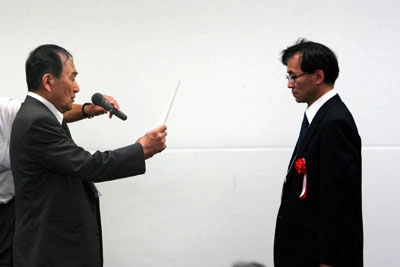

http://www.pref.niigata.lg.jp/HTML_Article/336/521/110827_besshi,0.pdf
This level of contamination, i.e. 76 Bq/kg,
is not serious but not safe. I wondered if my observing sites were
safe and measured radiation. I went to three major sites and confirmed
the
radiation dose rates. The dosimeter displayed 0.08 micro Sv/hour or
less that
is the same as natural value.
The situation at Fukushima Daiichi is still very serious, but little
information is released by the Japanese Government and the media. I am
afraid
quite a few people still live in highly contaminated areas, and I must
say the
government is inhumane. I hope it ends soon, though it would take one
century
or so.
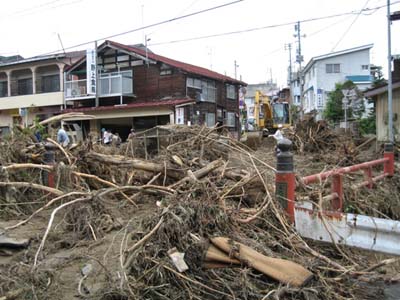
Floodwood with mudflow: about 300m from my office.
I usually commute by car crossing this red bridge.
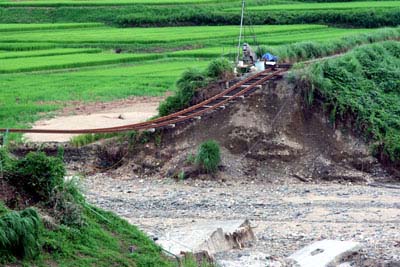
A bridge of the railway was lost by a swollen river.
Thursday, June 30

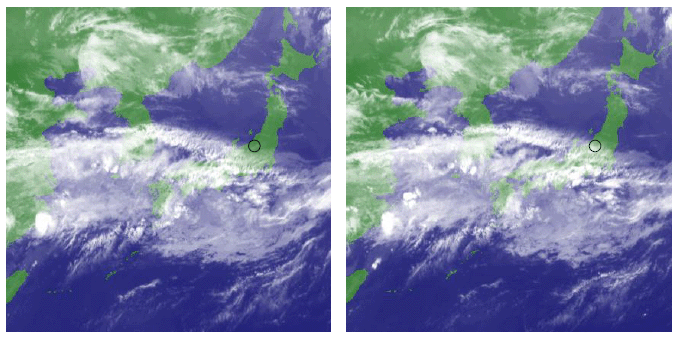
Sunday,
May 15
The
weather has been unstable this month and even if it was sunny yellow
sand from China made the sky dusty and I could comet hunt only once. I
had been waited for a clear sky, and finally the chance has come at
this predawn.
Waxing
moon set at 2:30a.m., but I started comet hunting before the moonset at
2:05a.m.: the twilight began at 2:55a.m. and I wanted to have enough
searching time. M15 was the starting point of the todayfs session.
NGC7177 was the first galaxy I identified during this session but it
looked featureless object.
The
second one was NGC7619 with another one only 7f apart from this galaxy.
Both of them were 11th magnitude but I had to spend several minutes to
identify the one near NGC7619. Here is a group of galaxies that
consists of over a dozen of them (see the map below). I confirmed
NGC7619 easily using the NGC Sky Vector, but there appeared some
candidates when it came to identifying the galaxy near NGC7619. I
opened a map, Uranometria 2000, and confirmed that the galaxy was
NGC7626.

A galaxy
group that contains NGC7619 and 7626. A circle indicates FOV of 1.3
degrees. MegaStar ver. 5.
The third one was NGC7479, a barred galaxy. I noticed the bar with a
hint of the spiral structure! All the objects I identified belong to
the constellation of Pegasus. When I was taking down my comet-seeker,
Jupiter and Venus, the angular distance of them was 3.3 degrees, rose
from the horizon. A beautiful daybreak!

NGC7479. This image is 10f wide.
The Digitized Sky
Survey copyright©1994
Saturday, April 30
I
got up at 1:30a.m. this predawn but the cloud covered the entire sky.
I have not been able to comet search for two weeks due to moonlight and
cloudy weather, though I swept the sky six times in total this month.
The
41st Comet Conference
I
have announced we will hold the 41st Comet Conference (CC) in Niigata
city on July 16 to 17, 2011 (refer to the diary on January 27),
but the venue has been changed. One reason is that the Asteroids, Comets,
Meteors meeting 2011 (ACM),which would have been held in Niigata,
is postponed because of the disaster. Another is the rolling blackout
that is planned in this summer in Niigata and some other area of Japan.
Many electric power plants were damaged by the quake and tsunami that
leads to lack of electricity.
New
venue
The new venue is the
Nobeyama, National Astronomical Observatory of Japan (NAOJ) where
no blackout is planned.
The date and the program are the same with the original plan: Dr.
Daniel E.W. Green, Director of CBAT and I will give presentations.
If you are interested in the CC please contact me.
Wednesday, April 6
Wonderful
sky! Many power plants had been damaged by the big earthquake and
tsunami, and we have to save electricity.
Usually
the ski fields around my city open from early in the morning at this
time of year with lighting at predawn. Some shops open 24 hours with
bright illumination. However, after the quake most lights have been
turned off and the sky became very dark.
I
realize that the Milky Way was much brighter than usual even at a low
altitude, and noticed the dark nebulae were easy to observe through my
46 cm comet-seeker. The stars shining in the Milky Way in Cygnus looked
like grains of golden sand scattered on velvet. Today the transparency
was not excellent but I reassured darkness of the sky is more important
than the clearness for star watching.
I swept
Cygnus and Pegasus, and identified only three DSOs: NGC6992 (veil
nebula), 7217 (galaxy) and 7331 (galaxy). C/2011 C McNaught was bright
with 9th magnitude, and this is the first observation for me. To date I
have enjoyed comet hunting three times this month.
Sunday, March 13
On
Friday, a giant earthquake with M9.0 struck northeastern Japan, and it
is estimated more than 10,000 people died. The government still does
not know how many people died or are missing. In Tohkamachi I felt a
shock that had a long-period oscillation, but not very strong.
Surprisingly,
another earthquake struck Tohkamachi at predawn on Saturday. The
epicenter of this earthquake was only about 20 km from my residence
with M6.8. The shock was very strong: some glasses and china bowls fell
down from the shelf and were broken. Seismologists said this earthquake
was completely different from the giant earthquake. It is unknown if
the two earthquakes are linked or not, but I guess they are.
I
conducted a comet hunting session this predawn, and mainly swept in the
constellation of Sagittarius. I imagined the vastness of the universe
from the countless numbers of stars I could see in the FOV.
Our
planet is trivial in the universe, and only a slight movement of the
small part of the plate triggers such a giant earthquake. However,
thanks to this crust motion the Islands of Japan was formed where we
live. All we can do is to accept the extraordinary natural phenomenon
and appreciate that we are alive.
Friday, February 25
I
have searched the predawn sky two days in a row, and this was the
eighth hunting session this month!
Yesterday,
I overlooked NGC 6712, an eighth magnitude globular cluster in Scutum,
because of the moonlight. Though the globular cluster was at an
altitude of only 16 degrees when it passed through the FOV of my
comet-seeker at 4:15a.m., I wonder if I made sense to do comet hunting
under such a bright sky condition. I trained my telescope on NGC6712 at
4:20a.m. using the digital setting circles, but I could not see it at a
glance: the image of this object was too faint to notice. I peered into
the FOV for a several second and I could manage to recognize this
"bright" object.
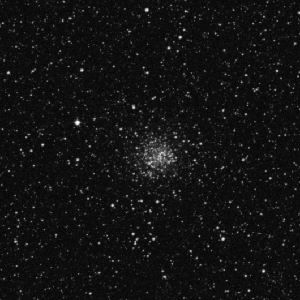
NGC
6712. Field: 15 arc minutes.
The Digitized Sky
Survey copyright©1994
On the
contrary, NGC6712 was obvious in the FOV today. The sky became much
darker than that of yesterday due to waning of moon.
I
started comet hunting at 3:55a.m. today and yesterday also. Yesterday,
there appeared no cloud throughout the session, but today the amount of
cloud increased as time went. Before 5a.m., the time when the twilight
began, some 50% of the sky was covered with cloud, and this situation
lasted till the end of the todayfs session at 5:30a.m. I searched where
the gap of the cloud opened, but the DSOs identified during this
session were no more than NGC6934 and M56. However, I was indeed
satisfied with the beauty of the starry sky!
Saturday, February 5
It
is incredible that I could comet hunt for consecutive days after over
one month of snowy weather, though not all the sessions were good
condition.
Wednesday
The sky was crystal clear since December 19 last year! I started comet
searching from a few degrees west of alpha Liberae. The first deep sky
object (DSO) I came across was NGC5824, a globular cluster in Lupus
with a large apparent diameter of 7f. The second one was NGC5634, a
globular cluster in Virgo that looked bluish with 78x, though
individual stars were not resolved. The third object was NGC5903, a
12th magnitude galaxy in Libra, and I noticed a companion galaxy
NGC5898 in the same field of view (FOV).
Beta
Scorpii, a double star, was jaw-dropping. The primary looked pure white
and I saw the secondary as yellowish, generally called blue, probably
because of the low altitude.
M4 in Scorpius was impressive, and I was completely satisfied with the
session.
Thursday
The transparency was as good as that in yesterday. I began to comet
hunt at Beta Scorpii and identified some 20 DSO during the session.
Most of them were globular clusters, and among the most interesting
objects were NGC6440 (globular cluster) and 6445 (planetary nebula).
Both could be seen in the same FOV and located about 1 degree
north-west of Venus.
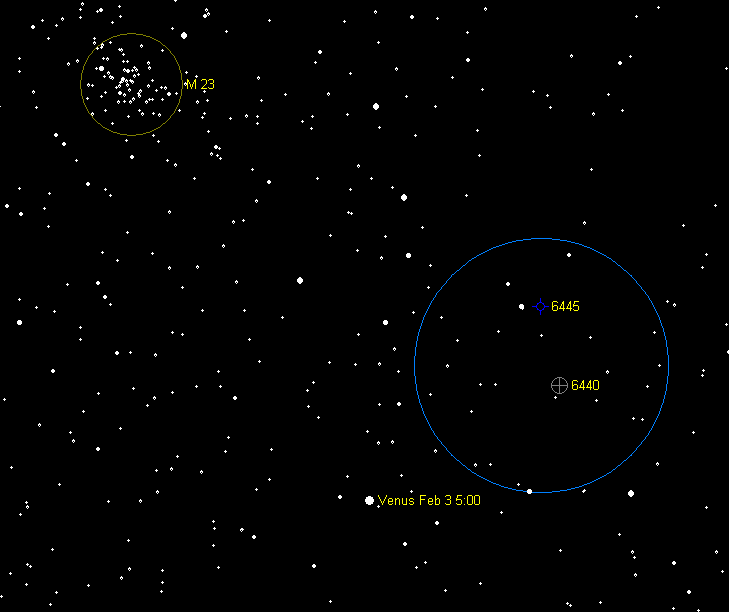 @ @ |
@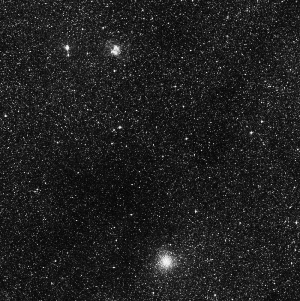 |
| M23, Venus, NGC6445 and NGC6440. A circle indicates the field
of view for 1.1 degrees. MegaStar ver.5. |
@NGC6445, a planetary nebula (upper), and NGC6440, a galaxy
in Libra. The image is 30f wide. The Digitized Sky Survey copyright©1994 |
Friday
Obviously, the transparency got worse in comparison with the previous
day. I searched mainly in the constellation of Ophiuchus, but as time
went the amount of cloud increased and I was forced to change the
search area due to cloud. I trained my comet-seeker to the south. I
identified NGC5878, a 12th galaxy in Libra, which I could not see in
Wednesday because the altitude of this object was low at that time.
Saturday
The sky looked hazy and I hesitated to go comet hunting. As a result, I
decided to go but when I set up my comet-seeker the cloud began to
cover the sky. I comet hunted for only 40 minutes till the sky got
cloudy.
Thursday, January 27
It
has been snowing for a few weeks and the snow depth has reached more
than 260 cm. People in my city guess it will be more than 3 m this
winter. There has been no chance to comet hunt this month here in
Tohkamachi.

There
are many restaurants and shops along this road. While I was driving, it
was difficult to find the entrance of the shops due to snow wall.
Announcement of the 41th Comet Conference in
Niigata City
The
41st Comet Conference (CC) will be held in Niigata City on Saturday
July 16 and Sunday July 17, and I chair the conference again: I did
last in
2007.
This
time CC is linked with the
Asteroids, Comets, Meteors meeting 2011 (ACM), July 17 to 22. ACM
is an international meeting for professional astronomers. The venue of
those two meetings are the same; Niigata Convention Center,
Toki Messe.
The
guest speaker of this yearfs CC is Dr. Daniel E.W. Green, Director of
CBAT. I also give a speech on the comet discovery as I was requested to
do. Dr. Greenfs lecture is translated into Japanese, and I will give
presentation both in English and Japanese. Other presentations are also
conducted with translation or bilingual explanations.
If you
have a trouble with the language, members of the Scientific Organizing
Committee of CC will help you.
The
Local Organizing Committee will have the first meeting next month. Most
members belong to the Niigata Astronomy Research Club (I do not know if
this is an official English name) or Niigata Tenmon Kenkyu
Kai in Japanese.
I am going to launch the web page in the near future.
Sunday, January 9
It has been three
weeks since I comet hunted last here in Tohkamachi. While these three
weeks, I had a comet hunting session in Nagano Prefecture in my way to
my motherfs house at the end of December. Winter weather at the central
or southern part of Nagano is generally fine in winter like at Ikeyafs
place, Shizuoka.
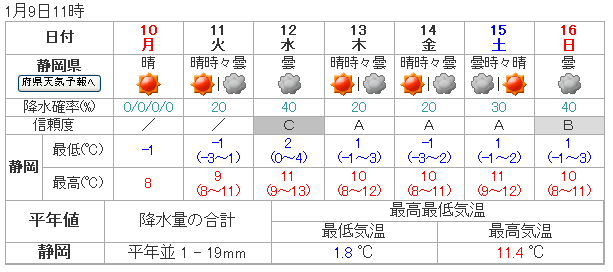
Weekly forecast at
Ikeyafs site (Shizuoka) Copyright Japan Meteorological Agency
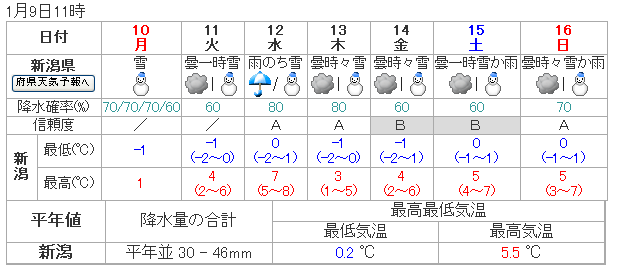
Weekly forecast in
my city (Niigata) Copyright Japan Meteorological Agency
Some people say that
it was incredible that I discovered two comets in the area of bad
weather condition. I see that this means I have always paid attention
to the sky conditions in combine with the forecasts not to miss clear
sky out. When I have a chance to conduct a hunting session, I
concentrate on sweeping the sky.
The starry sky looks
more beautiful after the long-term cloudy, rainy and/or snowy sky. The
chance of clear sky must be less than one third of that of Ikeyafs site
on an annual basis, and probably a tithe in winter.
I do not know when
the next searching session can be conducted, but the passion for
beautiful starry night is the motivating force for comet hunting that I
want to keep.
I wake up at 2a.m.
this predawn with a little hope for clear sky, but it was cloudy. I had
a look at the sky again at 3a.m. again, but the sky condition was the
same. OK, I will try the next time.
Top of this page